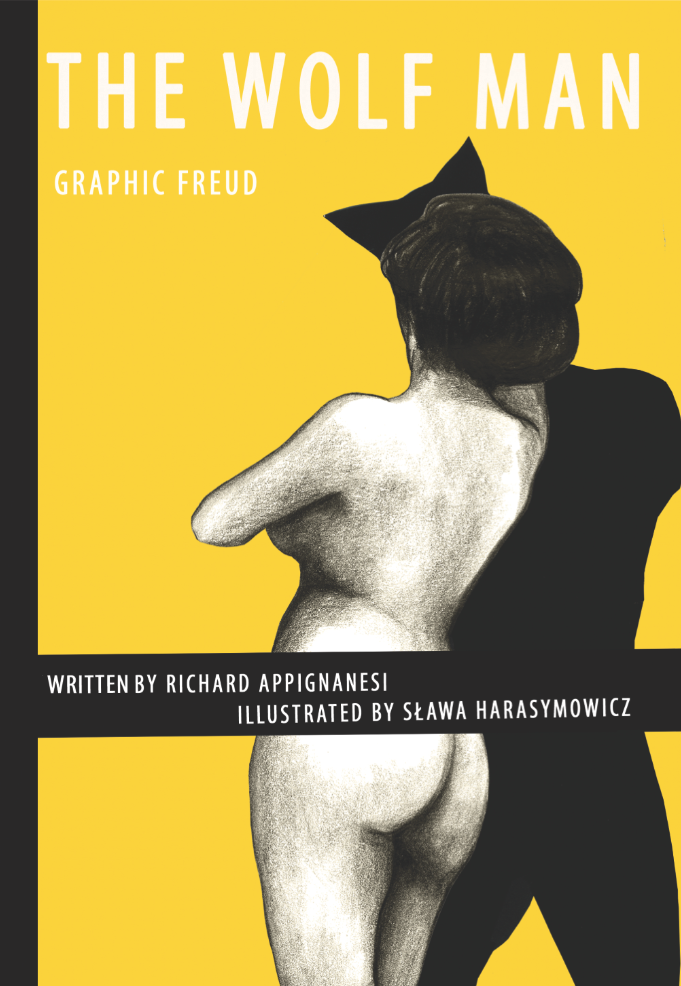The Wolf Man – written by Richard Appignanesi and illustrated by Sława Harasymowicz
Vienna, 1910. A young Russian aristocrat, Sergei Pankejeff , desperately seeks the help of Sigmund Freud at his home in Bergstrasse. Freud’s analysis comes to focus on his patient’s disturbing childhood dream of a menacing pack of white wolves perched on the tree outside his bedroom window. It was the interpretation of this dream that earned Pankejeff his enduring sobriquet “The Wolf Man” – and Freud his central position in modern thought. We follow the course of Pankejeff ’s troubled life, and the attempt by Freud, and subsequent analysts, to unravel the source of his crippling neurosis.

‘The Wolf Man’ – or ‘From the History of an Infantile Neurosis’ (1918), as Freud’s paper was originally titled – is one of the founding texts of modern psychoanalysis, and one of a series of clinical case histories from which Freud extrapolated his incalculably infl uential theories of psychosexual development. From “transference” to the Oedipus complex, the super-ego to the “primal scene”, the classic canon of Freud’s psychoanalytic writing blurred the boundary between science and literature, and continues to provoke fi erce debate to this day.
Pankejeff underwent what he called an ‘interminable analysis’ – almost to the end of his long life – during which bore witness to some of the century’s momentous events: from his early years under Tsarist privilege, the First World War, the Russian Revolution, the Nazi regime and the Cold War. Pankejeff was a remarkably resilient survivor. But was he ever ‘cured’? He himself remained uncertain.
“Psychoanalysis stands or falls on the claims that Freud makes for it in this case history: ‘The Wolf Man’ is crucial. Everything fundamental to psychoanalysis is contained in it. Sexual development in infancy, incest phantasy, gender identity, object choice, homosexuality, the formation of adult neurosis in childhood, dream interpretation – and of course the central question of psychoanalysis: can neurotic disorders buried in the unconscious be made conscious to the patient (analysand) by means only of the ‘talking cure’?” – Richard Appignanesi
“Freud is a masterly writer. His case histories are especially fascinating and graphic. I rank Freud among the greatest of Viennese novelists, Robert Musil, Hermann Broch, Josef Roth, to name a few of the best. Writing the Wolf Man case history caused Freud much trouble. It is frankly a mess. I have given it more narrative coherence in this graphic novel than it has in the original. The ambiguities and uncertainties are left in place. Let readers make up their own minds.” – Richard Appignanesi
“The greatest challenge in depicting Freud’s story visually was to create a narrative of reality, dream, memory and fact, which looks like it is just about to fall apart, yet, somehow doesn’t and is quite seductive – like the Wolf Man and his state of mind.” – Sława Harasymowicz
“I drew the graphic scenes exactly as they might have happened (or been witnessed). For me, it was about looking at the those moments from the point of view of someone who does not necessarily remember them clearly, and who has to switch between a child’s memory of an ambiguous ‘visual event’ and an adult’s understanding of it.” – Sława Harasymowicz

